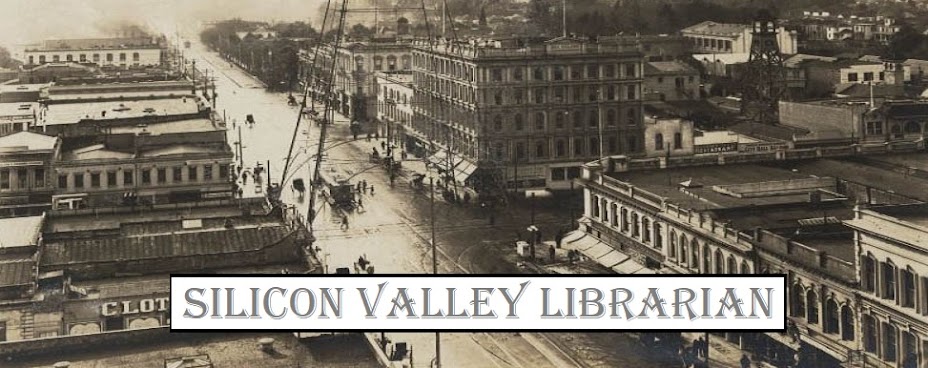Many notable technology giants were affiliated with what was once Stanford's horse farm and later became Stanford University.
Cyril Elwell, Fred Terman, William Hansen, William "Bill" Redington Hewlett, David Packard
 |
David Packard, William Hewlett and the
garage where their business began.
|
Roots of the World Wide Web, in alliance with CERN, reach Stanford:
Of particular note is the role of the Stanford Linear Accelerator (SLAC) in the development of the World Wide Web. In 1991 SLAC installed the first CERN Web server outside of Europe to collaborate and communicate with CERN scientists and physicists, as together they tried "to probe the fundamental structure of the universe...and the basic constituents of matter."
From the CERN Web site:
 |
| Stanford Linear Accelerator (SLAC) |
Tim Berners-Lee and Robert Cailliau developed the world's first browser,"WorldWideWeb" at CERN in 1990.
In November (of) that year, they presented a new coding language called hypertext (link is external) to CERN colleagues.
A month later, Berners-Lee and Cailliau used WorldWideWeb software for the first communication between a web client and a server (link is external) over the internet.
The machine at SLAC used the same software to serve several pages (link is external), including a phone book and pre-prints of papers on high-energy physics.
The world's first ever website and server, info.cern.ch, ran on a NeXT computer at CERN. The first web page address was:
http://info.cern.ch/hypertext/WWW/TheProject.html
That page centered on information regarding the WorldWideWeb project itself. Visitors could learn more about hypertext, technical details for creating their own webpages, and even an explanation on how to search the web for information. There are no screenshots of this original page and, in any case, changes were made daily to the information available on the page as the WorldWideWeb project developed. You may find a later copy (link is external), from 1992, on the World Wide Web Consortium website (link is external).
The web at CERN grew from info.cern.ch include a phonebook, high-energy physics papers, and general information about the experiments at the laboratory. Today CERN hosts over 10,000 websites, helping to keep a global community of physicists connected.
Today CERN hosts over 10,000 websites, helping to keep a global community of physicists connected.
(Quoted from the CERN Web site at: http://home.cern/about/updates/2012/12/month-1991-web-spreads-beyond-cern )
 |
| CERN (Conseil Européen pour la Recherche Nucléaire) in Geneva |
- Stanford University has an excellent history series online, which includes a section on the school's role in the rise of Silicon Valley.
- San Jose Public Library has an online collection with essays and images of the Women of Silicon Valley.
- The New York Times has an interesting 9-slide travelogue-type display online of Silicon Valley landmarks.
- Silicon Valley Historical Association has pages of interviews, company histories and other data on the pioneers of Silicon Valley.
- Locally, the Computer History Museum in Mountain view offers online exhibits showcasing Silicon Valley legends and computing milestones in world and local history.
- National Public Radio has an excellent timeline on the Birth of Silicon Valley in their Web site.
- The PBS Web site, American Experience: Silicon Valley, can be viewed online, along with Web resources, related books, images and other background information.
Local and Global Philanthropy in Silicon Valley:
- One of the premiere, enduring and global philanthropic entities in Silicon Valley is the William and Flora Hewlett Foundation:
 |
| William and Flora Hewlett (Wm. & Flora Hewlett Fdn.) |
"Never stifle a generous impulse," was a favorite saying of entrepreneur William R. Hewlett, who established the Hewlett Foundation with his wife, Flora Lamson Hewlett, and their eldest son, Walter B. Hewlett. Indeed, it was the personal generosity of Mr. Hewlett, who passed away in 2001, that has made the Hewlett Foundation one of the nation's largest, with assets of more than $9 billion. Click here for a brief biography of William R. Hewlett." (From the www.Hewlett.org Web site.)
- Stanford Graduate School of Business: Center for Social Innovation, offers articles and research on "Responsible Philanthropy," much of it based on trends from local corporate trends and studies. Students also participate in Service Days in the community. The public is invited to informative events designed to create a more sustainable world, strengthen non-profits, and increase corporate responsibility, based on community needs and philanthropic trends.
- The Silicon Valley Community Foundation offers links and resources to research philanthropic trends and opportunities in Silicon Valley.
- Silicon Valley Business Journal published an article on Silicon Valley's 25 Most Generous Companies in November of 2013.
- Philanthropy News Digest posted a story about Mark Zuckerberg's donation of nearly $1 billion in Facebook shares to the Silicon Valley Community Foundation in December 2013, excerpted from a Wall Street Journal article by Ben Fox Rubin.
- Philanthropy News Digest published a summary of top Silicon Valley donors of stock for 2012, excerpted from a Wall Street Journal article by Jessica E. Lessin.
- The Sobrato Organization published a list of top philanthropists donating to Silicon Valley organizations in 2011, as excerpted from a 2012-2013 Business Journal Giving Guide.
---Catherine Alexander Bright, SiliconValleyLibrarian.org
